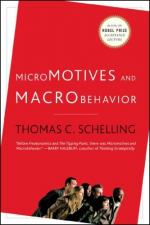
|
Chapter 1: Micromotives and Macrobehavior
• Schelling describes an exercise in seat selection as an example of population modeling.
• Spatial distribution is subject to mathematical but also subjective influences.
• There are different theories about why a theatre will fill the way it does.
• Economic theories of behavior tend to seek equilibrium.
Chapter 2: The Inescapable Mathematics of Musical Chairs
• Economic theories assign mathematical qualities to behavior in order to find equivalencies in values.
• Propositions are methods economists use to model human behavior.
• Economic models try to predict integration and segregation.
• Schelling describes the ways to constrain propositions to make them accurate.
Chapter 3: Thermostats, Lemons, and Other Families of Models
• The thermostat functions as a metaphor for cyclical processes.
• The thermostat model leads you to expect a lag time in cyclic processes.
• There are a number of models economists use to model different behaviors.
• Economic models try to predict behavior like social...
|
This section contains 452 words (approx. 2 pages at 300 words per page) |

|




